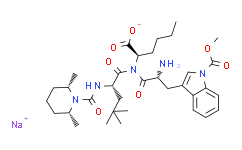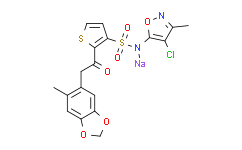| 中文名称: | BQ-788 sodium salt | ||||
|---|---|---|---|---|---|
| 英文名称: | BQ-788 sodium salt | ||||
| 别名: | 四氟间苯二甲醯亚胺;BQ-788 钠盐 sodium (R)-2-((R)-2-((S)-2-((2R,6S)-2,6-dimethylpiperidine-1-carboxamido)-4,4-dimethylpentanamido)-3-(1-(methoxycarbonyl)-1H-indol-3-yl)propanamido)hexanoate | ||||
| CAS No: | 156161-89-6 | 分子式: | C34H5N5NaO7 | 分子量: | 663.78 |
| CAS No: | 156161-89-6 | ||||
| 分子式: | C34H5N5NaO7 | ||||
| 分子量: | 663.78 | ||||
包装规格:
5mg in glass bottle
产品简介:
一种有效,选择性的ETB受体拮抗剂,在人类Girrardi心脏细胞中抑制ET-1与ETB受体结合的IC50为1.2nM。
溶解性:
溶于水(2.5mg/mL 超声),溶于DMSO(≥43mg/mL)
储备液保存:
该产品在溶液状态不稳定,建议您现用现配,即刻使用。
体内实验:
1、请依序添加每种溶剂: 10% DMSO→40% PEG300→5% Tween-80→45% Saline
Solubility: ≥ 3 mg/mL (4.52 mM); 澄清溶液
此方案可获得 ≥ 3 mg/mL(饱和度未知)的澄清溶液。
以 1 mL 工作液为例,取 100 μL 30.0 mg/mL 的澄清 DMSO 储备液加到 400 μL PEG300 中,混合均匀;再向上述体系中加入 50 μL Tween-80,混合均匀;然后再继续加入 450 μL 生理盐水 定容至 1 mL。
2、请依序添加每种溶剂: 10% DMSO→90% (20% SBE-β-CD in Saline)
Solubility: ≥ 3 mg/mL (4.52 mM); 澄清溶液
此方案可获得 ≥ 3 mg/mL(饱和度未知)的澄清溶液。
以 1 mL 工作液为例,取 100 μL 30.0 mg/mL 的澄清 DMSO 储备液加到 900 μL 20% 的 SBE-β-CD 生理盐水水溶液 中,混合均匀。
3、请依序添加每种溶剂: 10% DMSO→90% Corn Oil
Solubility: ≥ 3 mg/mL (4.52 mM); 澄清溶液
此方案可获得 ≥ 3 mg/mL(饱和度未知)的澄清溶液,此方案实验周期在半个月以上的动物实验酌情使用。
以 1 mL 工作液为例,取 100 μL 30.0 mg/mL 的澄清 DMSO 储备液加到 900 μL玉米油中,混合均匀。
<1mg/ml表示微溶或不溶。
普西唐提供的所有化合物浓度为内部测试所得,实际溶液度可能与公布值有所偏差,属于正常的批间细微差异现象。
请根据产品在不同溶剂中的溶解度选择合适的溶剂配制储备液;一旦配成溶液,请分装保存,避免反复冻融造成的产品失效。
Solubility: ≥ 3 mg/mL (4.52 mM); 澄清溶液
此方案可获得 ≥ 3 mg/mL(饱和度未知)的澄清溶液。
以 1 mL 工作液为例,取 100 μL 30.0 mg/mL 的澄清 DMSO 储备液加到 400 μL PEG300 中,混合均匀;再向上述体系中加入 50 μL Tween-80,混合均匀;然后再继续加入 450 μL 生理盐水 定容至 1 mL。
2、请依序添加每种溶剂: 10% DMSO→90% (20% SBE-β-CD in Saline)
Solubility: ≥ 3 mg/mL (4.52 mM); 澄清溶液
此方案可获得 ≥ 3 mg/mL(饱和度未知)的澄清溶液。
以 1 mL 工作液为例,取 100 μL 30.0 mg/mL 的澄清 DMSO 储备液加到 900 μL 20% 的 SBE-β-CD 生理盐水水溶液 中,混合均匀。
3、请依序添加每种溶剂: 10% DMSO→90% Corn Oil
Solubility: ≥ 3 mg/mL (4.52 mM); 澄清溶液
此方案可获得 ≥ 3 mg/mL(饱和度未知)的澄清溶液,此方案实验周期在半个月以上的动物实验酌情使用。
以 1 mL 工作液为例,取 100 μL 30.0 mg/mL 的澄清 DMSO 储备液加到 900 μL玉米油中,混合均匀。
<1mg/ml表示微溶或不溶。
普西唐提供的所有化合物浓度为内部测试所得,实际溶液度可能与公布值有所偏差,属于正常的批间细微差异现象。
请根据产品在不同溶剂中的溶解度选择合适的溶剂配制储备液;一旦配成溶液,请分装保存,避免反复冻融造成的产品失效。
靶点:
ETB
体外研究:
BQ-788 potently and competitively inhibits 125I-labeled ET-1 binding to ETB receptors in human Girrardi heart cells with an IC50 of 1.2 nM, but only poorly inhibits the binding to ETA receptors in human neuro-blastoma cell line SK-N-MC cells (IC50, 1300 nM). BQ-788 shows no agonistic activity up to 10 μM and competitively inhibits thevasoconstriction induced by an ETB-selective agonist (pA2, 8.4). BQ-788 also inhibits several bioactivities of ET-1, such as bronchoconstriction, cell proliferation, and clearance of perfused ET-1.
体内研究:
BQ-788 (3 mg/kg/h, i.v.) completely inhibits a pharmacological dose of ET-1- or sarafotoxin6c (0.5 nmol/kg, i.v.)-induced ETB receptor-mediated depressor, but not pressor responses in conscious rats. Furthermore, BQ-788 markedly increases the plasma concentration of ET-1, which is considered an index of potential ETB receptor blockade in vivo. In Dahl salt-sensitive hypertensive (DS) rats, BQ-788 (3 mg/kg/h, i.v.) increases blood pressure by about 20 mm Hg. It is reported that BQ-788 also inhibits ET-1-induced bronchoconstriction, tumor growth and lipopolysaccharide-induced organfailure. BQ 788 (3 mg/kg) results in an eightfold leftward shift in the ET-1 dose-response curve, suggesting a significant involvement of ETB dilator receptors. Mice are treated with 30 nmol BQ-788 by intraplantar, reduce mechanical hyperalgesia (47% and 42%), thermal hyperalgesia (68% and 76%), oedema (50% and 30%); myeloperoxidase activity (64% and 32%), and overt-pain like behaviours. Additionally, intraplantar treatment with clazosentan or BQ-788 decreases spinal (45% and 41%) and peripheral (47% and 47%) superoxide anion production as well as spinal (47% and 47%) and peripheral (33% and 54%) lipid peroxidation, respectively.
保存条件:
-20℃
注意事项:
1、为了您的安全和健康,请穿实验服并戴一次性手套操作。
2、以上信息仅做参考交流之用。
2、以上信息仅做参考交流之用。
UN码:
HazardClass:
危害声明:
安全说明:
搜索质检报告(COA)
参考文献 & 客户发表文献
本计算器可帮助您计算出特定溶液中溶质的质量、溶液浓度和体积之间的关系,公式为:
质量 (g) = 浓度 (mol/L) x 体积 (L) x 分子量 (g/mol)
摩尔浓度计算公式
用本工具协助配置特定浓度的溶液,使用的计算公式为:
开始浓度 x 开始体积 = 最终浓度 x 最终体积
稀释公式
稀释公式一般简略地表示为:C1V1 = C2V2 ( 输入 输出 )









